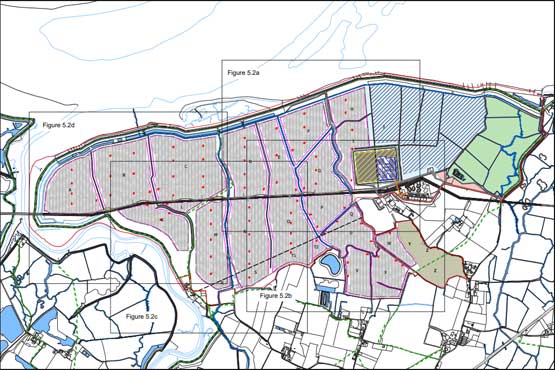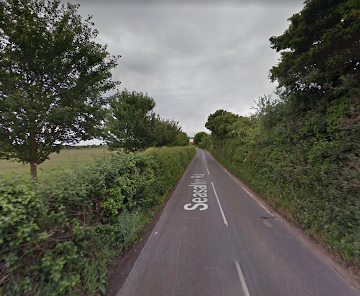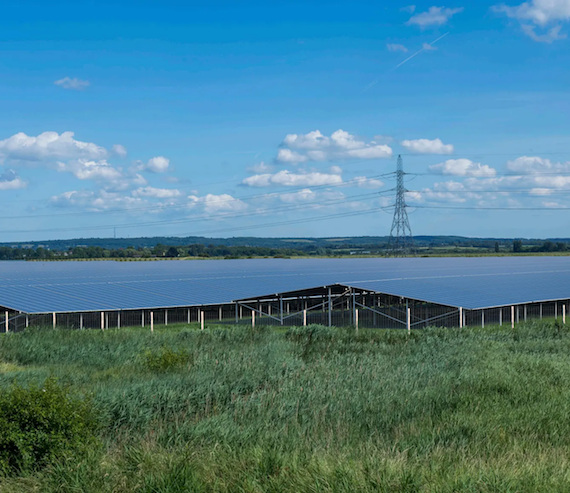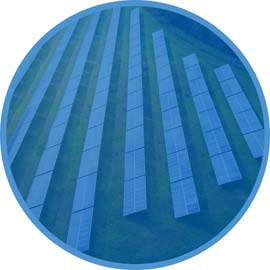Introduction
In 2017, Arcus Consultancy Services commissioned Pager Power Ltd to investigate and assess the possible effects of glint and glare from a proposed solar photovoltaic (PV) development located one mile northeast of Faversham, Kent, UK. The development is known as Cleve Hill Solar Park.
The solar park generation capacity is c. 350MW and includes c. 900,000 panels. The assessment modelled the effects of glint and glare upon ground level receptors including roads and dwellings. Aviation impacts were also considered at a high level.
The proposed panel area is shown in Figure 1 (solar array position shown in grey).
Background
Undertaking a glint and glare assessment for ground level receptors such as roads and dwellings is a common request for proposed solar developments across the UK.
It is Pager Power’s methodology to consider for assessment all roads and dwellings with 1km of a solar development.
Within 1km of Cleve Hill Solar Park lies Seasalter Road as well as a number of local and minor roads. Kent County Council had also requested that two local footpaths (ZR484 & ZR485) were considered in our assessment. There are also a number of individual dwellings as well as a densely populated area to the south east.
Seasalter Road is shown in Figure 2 (view facing solar park area).
The subsequent assessment was based on desk based data collection.
The Challenge
Particular challenges associated with this project were:
- The scale of the development, which qualified it as a Nationally Significant Infrastructure Project (NSIP).
- The modelling requirement for east-west orientated panels as opposed to the more standard south-facing panels.
- Specific requirements from Kent County Council pertaining to the assessment of public rights of way.
The Process
In the first instance, Pager Power identified all roads and dwellings within 1km of the solar farm which had a reasonable prospect of being able to view all or parts of the solar farm. This included assessment of Seasalter Road, two local footpaths (ZR484 and ZR485) and 82 dwellings.
After defining the panel boundary Pager Power’s glint and glare model was then used to determine whether a solar reflection was possible at the 143 identified receptors.
The model calculates the duration of potential effects from each area within the development based on the path of the Sun throughout the year, the relative position of the panels and the receptors in three dimensions and the physical orientation of the panels.
Where a solar reflection was geometrically was possible, a review of existing and proposed screening was completed to determine what effect, if any, existing vegetation would have on the visibility of the reflecting solar panels. The location of the Sun relative to the solar reflection at this time was also considered. In this way, the potential for glint and glare effects was quantified and evaluated.
Finally, considering all of the above, the overall expected impact for road users, footpath users and residents was determined.
The impact assessment process is based on many factors including:
-
- Whether reflections are geometrically possible.
- The duration of effects.
- The position of reflecting areas relative to an observer and the Sun.
The Solution
The potential effects on key receptors, including those specified by Kent County Council with specific reference to this project, were determined. The assessment concluded that significant impacts on safety due to glint and glare were not predicted for the development.
Figure 3 shows a visualisation of proposed Cleve Hill Solar Park.
The Result
The results of Pager Power’s Glint and Glare Assessment were accepted by the Secretary of State and the consent order was granted on 28th May 2020.
At the time of writing Cleve Hill Solar Park is set to be the largest solar development within the UK, and the first Solar Park to be classed as a Nationally Significant Infrastructure Project. Construction is expected to commence by 2021, and the generation of renewable energy by 2023.
References
[1] Provided to Pager Power by Arcus Consultancy Services Ltd (cropped)
[2] Source: © 2020 Google Street View. Image
[3] Source: https://infrastructure.planninginspectorate.gov.uk/wp-content/ipc/uploads/projects/EN010085/EN010085-000366-6.3.10%20Photomontage%20Y10%20-%20VP2%20-%20Summer.pdf. (cropped)

Figure 1: Panel area

Figure 2: Seasalter Road

Figure 3: Visualisation of Cleve Hill Solar Park
How can we help you today?



THE SECTORS WE SERVE




